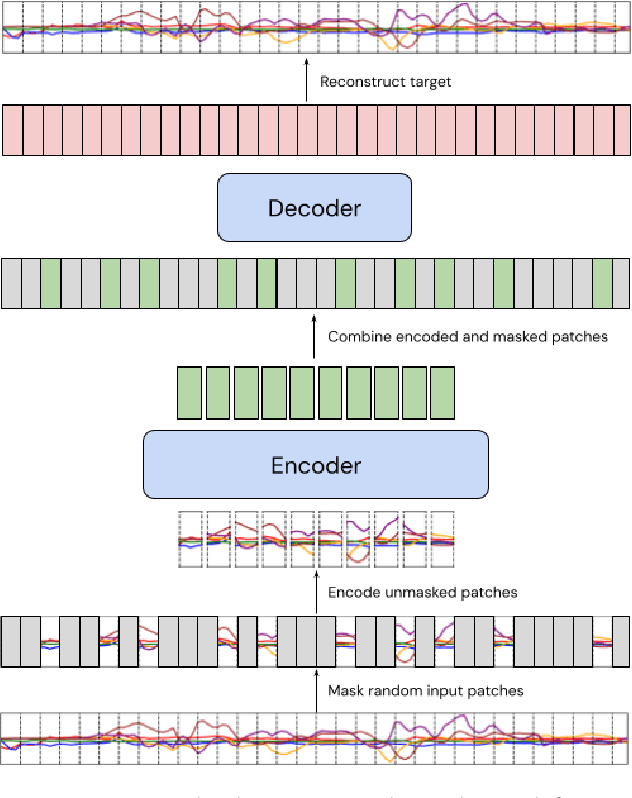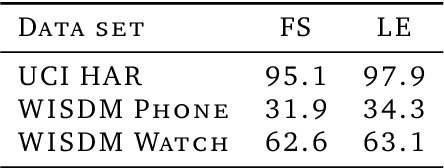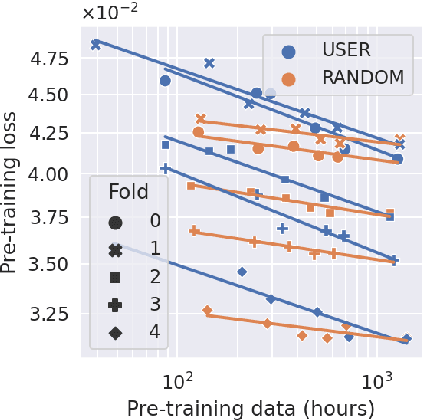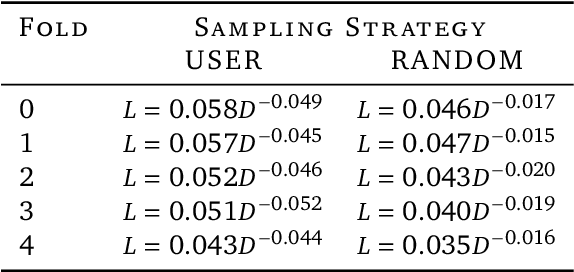Ali Etemad
Learning Time-Series Representations by Hierarchical Uniformity-Tolerance Latent Balancing
Oct 02, 2025Abstract:We propose TimeHUT, a novel method for learning time-series representations by hierarchical uniformity-tolerance balancing of contrastive representations. Our method uses two distinct losses to learn strong representations with the aim of striking an effective balance between uniformity and tolerance in the embedding space. First, TimeHUT uses a hierarchical setup to learn both instance-wise and temporal information from input time-series. Next, we integrate a temperature scheduler within the vanilla contrastive loss to balance the uniformity and tolerance characteristics of the embeddings. Additionally, a hierarchical angular margin loss enforces instance-wise and temporal contrast losses, creating geometric margins between positive and negative pairs of temporal sequences. This approach improves the coherence of positive pairs and their separation from the negatives, enhancing the capture of temporal dependencies within a time-series sample. We evaluate our approach on a wide range of tasks, namely 128 UCR and 30 UAE datasets for univariate and multivariate classification, as well as Yahoo and KPI datasets for anomaly detection. The results demonstrate that TimeHUT outperforms prior methods by considerable margins on classification, while obtaining competitive results for anomaly detection. Finally, detailed sensitivity and ablation studies are performed to evaluate different components and hyperparameters of our method.
VCRBench: Exploring Long-form Causal Reasoning Capabilities of Large Video Language Models
May 13, 2025Abstract:Despite recent advances in video understanding, the capabilities of Large Video Language Models (LVLMs) to perform video-based causal reasoning remains underexplored, largely due to the absence of relevant and dedicated benchmarks for evaluating causal reasoning in visually grounded and goal-driven settings. To fill this gap, we introduce a novel benchmark named Video-based long-form Causal Reasoning (VCRBench). We create VCRBench using procedural videos of simple everyday activities, where the steps are deliberately shuffled with each clip capturing a key causal event, to test whether LVLMs can identify, reason about, and correctly sequence the events needed to accomplish a specific goal. Moreover, the benchmark is carefully designed to prevent LVLMs from exploiting linguistic shortcuts, as seen in multiple-choice or binary QA formats, while also avoiding the challenges associated with evaluating open-ended QA. Our evaluation of state-of-the-art LVLMs on VCRBench suggests that these models struggle with video-based long-form causal reasoning, primarily due to their difficulty in modeling long-range causal dependencies directly from visual observations. As a simple step toward enabling such capabilities, we propose Recognition-Reasoning Decomposition (RRD), a modular approach that breaks video-based causal reasoning into two sub-tasks of video recognition and causal reasoning. Our experiments on VCRBench show that RRD significantly boosts accuracy on VCRBench, with gains of up to 25.2%. Finally, our thorough analysis reveals interesting insights, for instance, that LVLMs primarily rely on language knowledge for complex video-based long-form causal reasoning tasks.
Some Optimizers are More Equal: Understanding the Role of Optimizers in Group Fairness
Apr 21, 2025Abstract:We study whether and how the choice of optimization algorithm can impact group fairness in deep neural networks. Through stochastic differential equation analysis of optimization dynamics in an analytically tractable setup, we demonstrate that the choice of optimization algorithm indeed influences fairness outcomes, particularly under severe imbalance. Furthermore, we show that when comparing two categories of optimizers, adaptive methods and stochastic methods, RMSProp (from the adaptive category) has a higher likelihood of converging to fairer minima than SGD (from the stochastic category). Building on this insight, we derive two new theoretical guarantees showing that, under appropriate conditions, RMSProp exhibits fairer parameter updates and improved fairness in a single optimization step compared to SGD. We then validate these findings through extensive experiments on three publicly available datasets, namely CelebA, FairFace, and MS-COCO, across different tasks as facial expression recognition, gender classification, and multi-label classification, using various backbones. Considering multiple fairness definitions including equalized odds, equal opportunity, and demographic parity, adaptive optimizers like RMSProp and Adam consistently outperform SGD in terms of group fairness, while maintaining comparable predictive accuracy. Our results highlight the role of adaptive updates as a crucial yet overlooked mechanism for promoting fair outcomes.
Learning from Stochastic Teacher Representations Using Student-Guided Knowledge Distillation
Apr 19, 2025Abstract:Advances in self-distillation have shown that when knowledge is distilled from a teacher to a student using the same deep learning (DL) architecture, the student performance can surpass the teacher particularly when the network is overparameterized and the teacher is trained with early stopping. Alternatively, ensemble learning also improves performance, although training, storing, and deploying multiple models becomes impractical as the number of models grows. Even distilling an ensemble to a single student model or weight averaging methods first requires training of multiple teacher models and does not fully leverage the inherent stochasticity for generating and distilling diversity in DL models. These constraints are particularly prohibitive in resource-constrained or latency-sensitive applications such as wearable devices. This paper proposes to train only one model and generate multiple diverse teacher representations using distillation-time dropout. However, generating these representations stochastically leads to noisy representations that are misaligned with the learned task. To overcome this problem, a novel stochastic self-distillation (SSD) training strategy is introduced for filtering and weighting teacher representation to distill from task-relevant representations only, using student-guided knowledge distillation (SGKD). The student representation at each distillation step is used as authority to guide the distillation process. Experimental results on real-world affective computing, wearable/biosignal datasets from the UCR Archive, the HAR dataset, and image classification datasets show that the proposed SSD method can outperform state-of-the-art methods without increasing the model size at both training and testing time, and incurs negligible computational complexity compared to state-of-the-art ensemble learning and weight averaging methods.
Self-alignment of Large Video Language Models with Refined Regularized Preference Optimization
Apr 16, 2025Abstract:Despite recent advances in Large Video Language Models (LVLMs), they still struggle with fine-grained temporal understanding, hallucinate, and often make simple mistakes on even simple video question-answering tasks, all of which pose significant challenges to their safe and reliable deployment in real-world applications. To address these limitations, we propose a self-alignment framework that enables LVLMs to learn from their own errors. Our proposed framework first obtains a training set of preferred and non-preferred response pairs, where non-preferred responses are generated by incorporating common error patterns that often occur due to inadequate spatio-temporal understanding, spurious correlations between co-occurring concepts, and over-reliance on linguistic cues while neglecting the vision modality, among others. To facilitate self-alignment of LVLMs with the constructed preferred and non-preferred response pairs, we introduce Refined Regularized Preference Optimization (RRPO), a novel preference optimization method that utilizes sub-sequence-level refined rewards and token-wise KL regularization to address the limitations of Direct Preference Optimization (DPO). We demonstrate that RRPO achieves more precise alignment and more stable training compared to DPO. Our experiments and analysis validate the effectiveness of our approach across diverse video tasks, including video hallucination, short- and long-video understanding, and fine-grained temporal reasoning.
Advancing Medical Representation Learning Through High-Quality Data
Mar 18, 2025Abstract:Despite the growing scale of medical Vision-Language datasets, the impact of dataset quality on model performance remains under-explored. We introduce Open-PMC, a high-quality medical dataset from PubMed Central, containing 2.2 million image-text pairs, enriched with image modality annotations, subfigures, and summarized in-text references. Notably, the in-text references provide richer medical context, extending beyond the abstract information typically found in captions. Through extensive experiments, we benchmark Open-PMC against larger datasets across retrieval and zero-shot classification tasks. Our results show that dataset quality-not just size-drives significant performance gains. We complement our benchmark with an in-depth analysis of feature representation. Our findings highlight the crucial role of data curation quality in advancing multimodal medical AI. We release Open-PMC, along with the trained models and our codebase.
A Shared Encoder Approach to Multimodal Representation Learning
Mar 03, 2025Abstract:Multimodal representation learning has demonstrated remarkable potential in enabling models to process and integrate diverse data modalities, such as text and images, for improved understanding and performance. While the medical domain can benefit significantly from this paradigm, the scarcity of paired multimodal data and reliance on proprietary or pretrained encoders pose significant challenges. In this work, we present a shared encoder framework for multimodal representation learning tailored to the medical domain. Our approach employs a single set of encoder parameters shared across modalities, augmented with learnable modality features. Empirical results demonstrate that our shared encoder idea achieves superior performance compared to separate modality-specific encoders, demonstrating improved generalization in data-constrained settings. Notably, the performance gains are more pronounced with fewer training examples, underscoring the efficiency of our shared encoder framework for real-world medical applications with limited data. Our code and experiment setup are available at https://github.com/VectorInstitute/shared_encoder.
Task-agnostic Prompt Compression with Context-aware Sentence Embedding and Reward-guided Task Descriptor
Feb 19, 2025Abstract:The rise of Large Language Models (LLMs) has led to significant interest in prompt compression, a technique aimed at reducing the length of input prompts while preserving critical information. However, the prominent approaches in prompt compression often require explicit questions or handcrafted templates for compression, limiting their generalizability. We propose Task-agnostic Prompt Compression (TPC), a novel framework that generalizes compression across tasks and domains without requiring input questions or templates. TPC generates a context-relevant task description using a task descriptor trained on a curated dataset of context and query pairs, and fine-tuned via reinforcement learning with a reward function designed to capture the most relevant information. The task descriptor is then utilized to compute the relevance of each sentence in the prompt to generate the compressed prompt. We introduce 3 model sizes (Base, Large, and Huge), where the largest model outperforms the existing state-of-the-art methods on LongBench and ZeroSCROLLS benchmarks, and our smallest model performs comparable to the existing solutions while being considerably smaller.
Scaling laws in wearable human activity recognition
Feb 05, 2025



Abstract:Many deep architectures and self-supervised pre-training techniques have been proposed for human activity recognition (HAR) from wearable multimodal sensors. Scaling laws have the potential to help move towards more principled design by linking model capacity with pre-training data volume. Yet, scaling laws have not been established for HAR to the same extent as in language and vision. By conducting an exhaustive grid search on both amount of pre-training data and Transformer architectures, we establish the first known scaling laws for HAR. We show that pre-training loss scales with a power law relationship to amount of data and parameter count and that increasing the number of users in a dataset results in a steeper improvement in performance than increasing data per user, indicating that diversity of pre-training data is important, which contrasts to some previously reported findings in self-supervised HAR. We show that these scaling laws translate to downstream performance improvements on three HAR benchmark datasets of postures, modes of locomotion and activities of daily living: UCI HAR and WISDM Phone and WISDM Watch. Finally, we suggest some previously published works should be revisited in light of these scaling laws with more adequate model capacities.
SelfPrompt: Confidence-Aware Semi-Supervised Tuning for Robust Vision-Language Model Adaptation
Jan 24, 2025Abstract:We present SelfPrompt, a novel prompt-tuning approach for vision-language models (VLMs) in a semi-supervised learning setup. Existing methods for tuning VLMs in semi-supervised setups struggle with the negative impact of the miscalibrated VLMs on pseudo-labelling, and the accumulation of noisy pseudo-labels. SelfPrompt addresses these challenges by introducing a cluster-guided pseudo-labelling method that improves pseudo-label accuracy, and a confidence-aware semi-supervised learning module that maximizes the utilization of unlabelled data by combining supervised learning and weakly-supervised learning. Additionally, we investigate our method in an active semi-supervised learning setup, where the labelled set is strategically selected to ensure the best utilization of a limited labelling budget. To this end, we propose a weakly-supervised sampling technique that selects a diverse and representative labelled set, which can be seamlessly integrated into existing methods to enhance their performance. We conduct extensive evaluations across 13 datasets, significantly surpassing state-of-the-art performances with average improvements of 6.23% in standard semi-supervised learning, 6.25% in active semi-supervised learning, and 4.9% in base-to-novel generalization, using a 2-shot setup. Furthermore, SelfPrompt shows excellent generalization in single-shot settings, achieving an average improvement of 11.78%.
 Add to Chrome
Add to Chrome Add to Firefox
Add to Firefox Add to Edge
Add to Edge